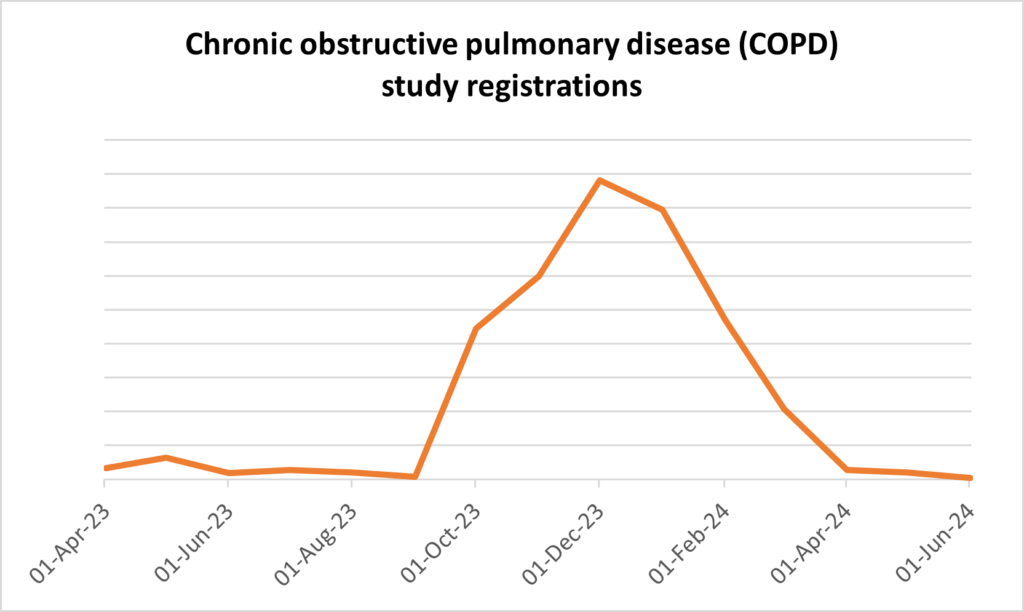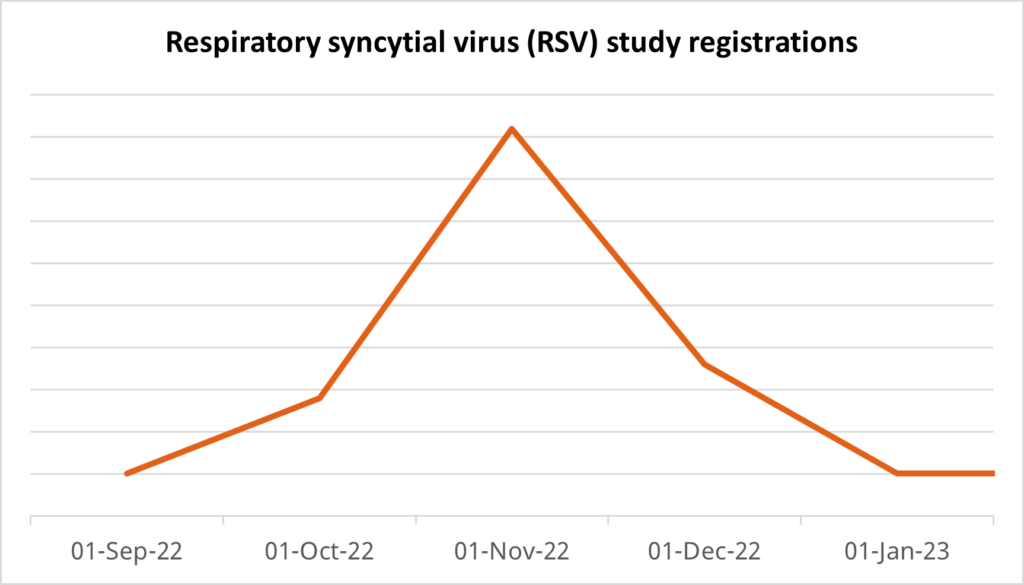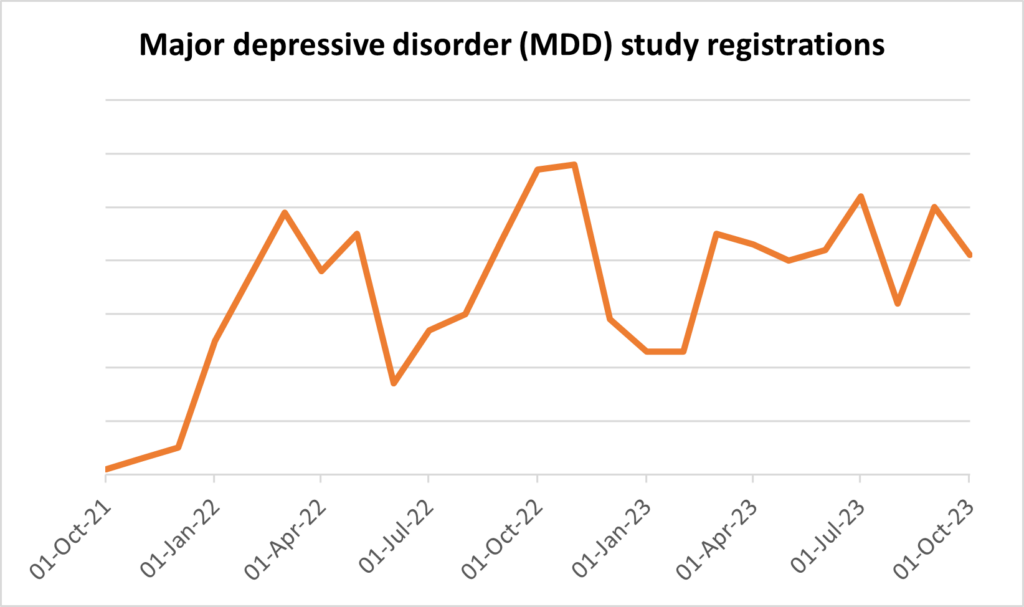2 September 2024 by Gabrielle Platt, Content Marketing Manager
As winter approaches, it’s crucial to prepare for the seasonal surge in patient traffic. Each year, colder weather brings an uptick in illnesses. Now is the perfect time to plan ahead and ensure you catch the winter wave of patients. In this blog, we’ll explore the indications that emerge every winter. As the days get shorter and colder, patients search for treatment options as symptoms worsen with the effects of the season.
Over almost two decades, we’ve observed noticeable surges in study registrations between November and March for certain indications. Let’s dive in!
Chronic Obstructive Pulmonary Disease (COPD)

We see a clear surge in study registrations for Chronic Obstructive Pulmonary Disease (COPD)beginning in September as temperatures start to drop. The symptoms of COPD are 30% more likely to be exacerbated in winter than spring or summer, with the affected airways and lungs impacted by the cold, dry air.
Click here to learn more about our experience supporting COPD trials and view our recent COPD case study here where we made a 20% contribution to total randomizations while reducing cost per study registration to 51% of our budget, and cost per referral at 28% of the planned budget.
Respiratory syncytial virus (RSV)

An example of the need to plan early, study registrations for Respiratory syncytial virus (RSV) vaccination trials tend to peak in November, in the run up to winter as patients prepare for the flu season.
We have supported over 60 RSV studies, find out how we can support your RSV trial here.
Major depressive disorder

It is well known that the symptoms of major depressive disorder can be heightened during the winter months – with less sunlight affecting serotonin levels and circadian rhythms, contributing to a higher severity of shifts in mood and hormones. Winter’s weather conditions can promote further isolation, feelings of despair and irritability and lethargy. We see this reflected in the peaks in study registrations beginning as the days get shorter in November as patients prepare for those darker months. For one sponsor we enrolled patients at 71% less cost than a major depressive disorder study’s previous recruitment vendor. Read the case study here.
Read our blog on how digital patient recruitment can dramatically reduce enrollment costs for major depressive disorder studies.
Chronic rhinosinusitis

Our data shows that chronic rhinosinusitis study registrations begin to rise in November and peak in the middle of winter, around January, as patients experience an increase in flare-ups. The stress of a busy holiday season, increases in environmental factors such as mold from damp environments, dust from common winter household items like blankets and seasonal allergens can all trigger worsened symptoms.
Inspired by this positive trend in patient interest and ready to start planning your chronic rhinosinusitis study? Read our blog on maximizing patient recruitment for chronic rhinosinusitis trials in a competitive market. For more, read our case study to discover how we over-achieved our target referrals at less than the planned cost.
Patients seeking treatment for winter flare-ups: A patient pool full of potential

The above indications are not an exhaustive list, there are many people living with indications that worsen in winter, such as multiple sclerosis (MS), where 20% of people living with MS report worsened symptoms during winter. This figure is unsurprising considering 60-80% of people living with MS have temperature sensitivity, where increases or decreases in body temperature can temporarily exacerbate neurological symptoms.
Skin conditions such as atopic dermatitis and psoriasis can flare up during winter, with the changing temperatures and dry air from indoor heating triggering skin dryness and itchiness, leaving a large pool of patients looking for relief.
We all spend more time indoors in winter, often exercising less and eating more. For people living with obesity this can contribute to a spike in obesity-related complications. Our Patient Insights team recently surveyed people who identified as being overweight and found that 62% of respondents were willing to participate in a trial for a new weight loss medication.
Our patient centric approach to obesity trials has seen us successfully refer over 150 patients, achieving a 75% reduction in cost per obesity patient compared to the industry standard. Are you ready to reach these patients this winter, or will you have to wait until next year?
Similarly, due to the different social and behavioral patterns in winter, people with Type 2 diabetes can experience rises in blood sugar levels in this time, bringing their condition – and potential ways to offset intensifying symptoms, into focus. Read our full interview with a Principal Investigator in diabetes clinical trials on the importance of understanding the patient perspective among Diabetes patients. You can also view our diabetes case studies here to see how we’ve driven over 1.6 million in patient traffic to our ClinLife® patient portal.
Ready to brace your study for winter?
Now that you are aware of the winter indicational trends, are you taking advantage of this seasonal momentum? Or will you be left out in the cold?
To see how we recruit for these trending indications, download our winter recruitment resource and become a winter patient recruitment expert by reading our blog from last winter.